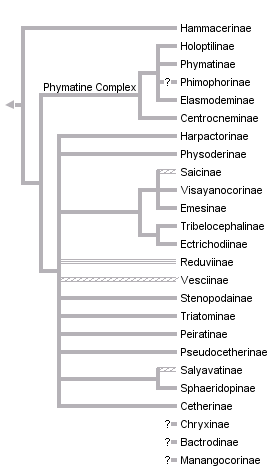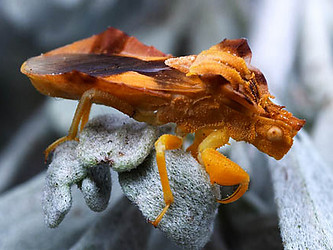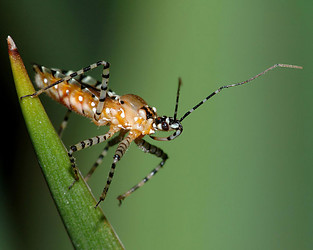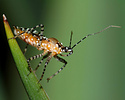Reduviidae
Assassin bugs, ambush bugs, wheel bugs, and thread-legged bugs



This tree diagram shows the relationships between several groups of organisms.
The root of the current tree connects the organisms featured in this tree to their containing group and the rest of the Tree of Life. The basal branching point in the tree represents the ancestor of the other groups in the tree. This ancestor diversified over time into several descendent subgroups, which are represented as internal nodes and terminal taxa to the right.

You can click on the root to travel down the Tree of Life all the way to the root of all Life, and you can click on the names of descendent subgroups to travel up the Tree of Life all the way to individual species.
For more information on ToL tree formatting, please see Interpreting the Tree or Classification. To learn more about phylogenetic trees, please visit our Phylogenetic Biology pages.
close boxReferences
Bargues, M.D., Marcilla, A., Ramsey, J.M., Dujardin, J.P., Schofield, C.J. and Mas-Coma, S. 2000. Nuclear rDNA-based molecular clock of the evolution of Triatominae (Hemiptera: Reduviidae), vectors of Chagas disease. Memorias do Instituto Oswaldo Cruz 95:567573.
Davis, N.T. 1961. Morphology and phylogeny of the Reduvioidea (Hemiptera: Heteroptera). Part II. Wing venation. Annals of the Entomological Society of America 54:340354.
Davis, N.T. 1966. Contributions to the morphology and phylogeny of the Reduvioidea (Hemiptera: Heteroptera). Part III. The male and female genitalia. Annals of the Entomological Society of America 59:911924.
Davis, N.T. 1969.Contribution to the morphology and phylogeny of the Reduvoidea. Part 4. The harpactoroid complex. Annals of the Entomological Society of America 62:7494.
Dougherty, V. 1995. A review of the New World Ectrichodiinae genera (Hemiptera: Reduviidae). Transactions of the American Entomological Society 121:173225.
Froeschner, R.C. and Kormilev, N.A. 1989. Phymatidae or ambush bugs of the world: a synonymic list with keys to species, except Lophoscutus and Phymata (Hemiptera). Entomography 6:176.
Hypsa, V., Tietz, D.F., Zrzavy, J., Rego, R.O.M., Galvao, C. and Jurberg, J. 2002. Phylogeny and biogeography of Triatominae (Hemiptera: Reduviidae): Molecular evidence of a New World origin of the Asiatic clade. Molecular Phylogenetics and Evolution 23:447457.
Lent, H. and Wygodzinsky, P. 1979. Revision of the Triatominae (Hemiptera, Reduviidae), and their significance as vectors of Chagas disease. Bulletin of the American Museum of Natural History 163:125520.
Maldonado, J. 1990. Systematic catalogue of the Reduviidae of the world (Insecta: Heteroptera). Caribbean Journal of Science, Special Edition, University of Puerto Rico, Mayagόez, pp. 1694.
Malipatil, M.B. 1985. Revision of Australian Holoptilinae (Reduviidae: Heteroptera). Australian Journal of Zoology 33:283299.
Paula, A.S. de, Diotaiuti, L. and Schofield, C.J. 2005. Testing the sister-group relationship of the Rhodniini and Triatomini (Insecta: Hemiptera: Reduviidae: Triatominae). Molecular Phylogenetics and Evolution 35:712718.
Putshkov, V.G. and Putshkov, P.V. (19861989) A catalogue of the Reduviidae (Heteroptera) of the world, 6 volumes. Vinity, Lyubertsy
Readio, P.A. (1927) Studies on the biology of the Reduviidae of America north of Mexico. The University of Kansas Science bulletin, 17, 1248.
Schofield, C.J. 1988. Biosystematics of the Triatominae. In Biosystematics of Haemotophagous Insects, pp. 284312. Clarendon Press, Oxford, U.K.
Schuh, R.T. and J.A. Slater. 1995. True Bugs of the World (Hemiptera: Heteroptera). Classification and Natural History. Cornell University Press, Ithaca, New York. xii + 336 pp.
Schuh, R.T., and P. Stys. 1991. Phylogenetic analyis of cimicomorphan family relationships (Heteroptera). Journal of the New York Entomological Society, 99:298-350.
Usinger, R.L. 1943. A revised classification of the Reduvioidea with a new subfamily from South America (Hemiptera). Annals of the Entomological Society of America 36:502618.
Weirauch, C. 2003. Pedicellar structures in Reduviidae (Heteroptera): Comments on cave organ and trichobothria. European Journal of Entomology 100:571580.
Weirauch, C. 2004. Distribution of a sternal glandular area among female Reduviidae (Heteroptera), with discussion of a possible pheromonal function. Mitteilungen aus dem Museum fόr Naturkunde in Berlin Deutsche Entomologische Zeitschrift 51:36.
Weirauch, C. 2005. Pretarsal structures in Reduviidae (Heteroptera, Insecta). Acta Zoologica 86:91110.
Weirauch, C. 2006. Metathoracic glands and associated evaporatory structures in Reduvioidea (Heteroptera: Cimicomorpha), with observation on the mode of function of the metacoxal comb. European Journal of Entomology 103:97108.
Weirauch, C. 2006. Dorsal abdominal glands in adult Reduviidae (Heteroptera, Cimicomorpha). Deutsche Entomologische Zeitschrift 53:91102.
Weirauch, C. 2006. New genus and species of Physoderinae (Heteroptera: Reduviidae) from the New World with a revised diagnosis of Physoderinae Miller. American Museum Novitates 3510:19.
Weirauch, C. 2007. Hairy attachment structures in Reduviidae (Cimicomorpha, Heteroptera), with observations on the fossula spongiosa in some other Cimicomorpha. Zoologischer Anzeiger 246:155157.
Weirauch, C. 2008. Cladistic analysis of Reduviidae (Heteroptera: Cimicomorpha) based on morphological characters. Systematic Entomology 33(2):229-274.
Wygodzinsky, P.W. 1966. A monograph of the Emesinae (Reduviidae: Hemiptera). Bulletin of the American Museum of Natural History 133:1614.
Wygodzinsky, P.W. & Lodhi, S. 1989. Atlas of antennal trichobothria in the Pachynomidae and Reduviidae (Heteroptera). Journal of the New York Entomological Society 97:371393.
Title Illustrations

| Scientific Name | Phymata sp. |
|---|---|
| Location | Northern Sierra Nevada, California, USA |
| Comments | Assassin bug |
| Specimen Condition | Live Specimen |
| Life Cycle Stage | Adult |
| Copyright |
© 2004 Alex Wild

|
| Scientific Name | Pselliopus cinctus |
|---|---|
| Location | Maryland, United States |
| Specimen Condition | Live Specimen |
| Life Cycle Stage | adult |
| Source | #1366047 |
| Source Collection | Bugwood Network/Forestry Images |
| Image Use |
 This media file is licensed under the Creative Commons Attribution License - Version 3.0. This media file is licensed under the Creative Commons Attribution License - Version 3.0.
|
| Copyright | © Susan Ellis |
About This Page
Page copyright © 2008
 Page: Tree of Life
Reduviidae. Assassin bugs, ambush bugs, wheel bugs, and thread-legged bugs.
The TEXT of this page is licensed under the
Creative Commons Attribution-NonCommercial License - Version 3.0. Note that images and other media
featured on this page are each governed by their own license, and they may or may not be available
for reuse. Click on an image or a media link to access the media data window, which provides the
relevant licensing information. For the general terms and conditions of ToL material reuse and
redistribution, please see the Tree of Life Copyright
Policies.
Page: Tree of Life
Reduviidae. Assassin bugs, ambush bugs, wheel bugs, and thread-legged bugs.
The TEXT of this page is licensed under the
Creative Commons Attribution-NonCommercial License - Version 3.0. Note that images and other media
featured on this page are each governed by their own license, and they may or may not be available
for reuse. Click on an image or a media link to access the media data window, which provides the
relevant licensing information. For the general terms and conditions of ToL material reuse and
redistribution, please see the Tree of Life Copyright
Policies.
- First online 21 June 2005
- Content changed 12 March 2008
Citing this page:
Tree of Life Web Project. 2008. Reduviidae. Assassin bugs, ambush bugs, wheel bugs, and thread-legged bugs. Version 12 March 2008 (temporary). http://tolweb.org/Reduviidae/10862/2008.03.12 in The Tree of Life Web Project, http://tolweb.org/









 Go to quick links
Go to quick search
Go to navigation for this section of the ToL site
Go to detailed links for the ToL site
Go to quick links
Go to quick search
Go to navigation for this section of the ToL site
Go to detailed links for the ToL site